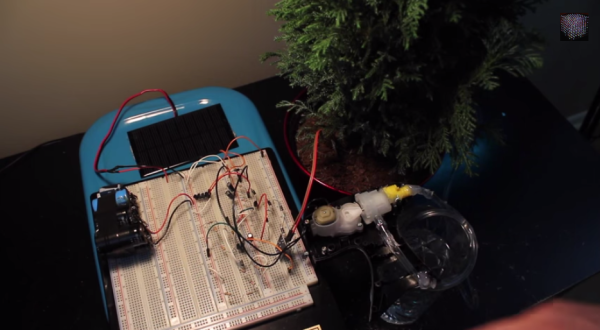Plants are a nice addition to most any habitat. Many of them bear flowers or attractive foliage, some of them help filter the air, and others, like aloe vera, have medicinal properties. While some plants require very little care, they all need a little moisture at some point. Overall, plant care is a bit fiddly: water them too much and you run the risk of root rot; water too little and risk death by dehydration. Hackaday alum [Kevin Darrah] would prefer not to gamble with either condition, and so in the course of a weekend’s time, he constructed a solar-powered automatic plant watering system from components he had on hand.
While he likely had a microcontroller or two lying around, he didn’t use one. His is a system of MOSFETs that trigger a motorized pump from one of those automatic bug spray bottles to draw from a reservoir and water the plant. The solar panel charges a bank of 6800µF capacitors that [Kevin] took out of an old receiver. When the desired charge is reached, the small soil sensor module is powered, assessing the moisture level. If the level is below the threshold determined by a trimmer pot, the power from the capacitor bank is dumped to the water pump and his plant gets a drink.
[Kevin]’s design deals nicely with the possible pitfalls of solar power. He’s included a 0.1µF cap to ensure latching through the system, and added a bleed resistor so that the pump is never powered unnecessarily. After running it for a couple of days, he’s already seeing moisture regulation in the soil. His complete demonstration and theory of operation is after the break. If you’re into solar power but aren’t quite ready to ditch the µC, check out this Arduino-controlled solution for thirsty tomatoes or this PIC-powered plant pacifier.
Continue reading “Automatic Plant Care Minus The Microcontroller”











